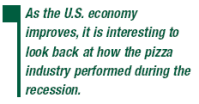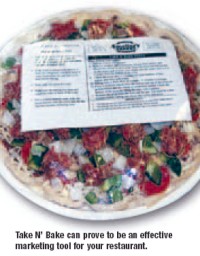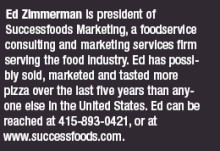 This economic pullback is the first one where pizza sales fell rather than increased. Traditional wisdom offers that in recessions, consumers eat more pizza. Here are some thoughts and reasons why we saw different results during this business cycle and what it might mean for our future.
This economic pullback is the first one where pizza sales fell rather than increased. Traditional wisdom offers that in recessions, consumers eat more pizza. Here are some thoughts and reasons why we saw different results during this business cycle and what it might mean for our future.
Pizza remains America’s favorite food. At $30 billion a year in sales, pizza racks up more U.S. food dollars than any other single segment. The system to “deliver” pizza to consumers is a well-balanced machine. Competition is fierce in this mature market but most players along the channel prosper; from the ingredient producers to the pizzeria distributors to the 63,000 pizza shop operators. Here are seven structural factors affecting the incremental demand for pizza.
The Price of Pizza
Traditionally, pizza flourished in poor economic times because it was inexpensive. It has roots as a peasant food, designed to keep the stomach full for a small cost. Ten years ago, a large pepperoni pizza was $7; today it is $14. The perception that a large pizza for a family of four represents a cheap meal is in the past. Today, pizza is a moderately priced family alternative, not a cheap belly stuffer.
Solution: Offer “Value Meals” like the burger chains that include salads and drinks for one price. You might offer a slightly smaller size pizza as part of that mix. Additionally, loyalty cards that offer free goods build the value perception.
Population Shifts
It is well documented that the Hispanic population has taken off in the United States. Hispanics represent the largest minority population segment in the U.S. and growing rapidly. Hispanics have brought their own culture and food; pizza is not among those traditional choices. Tacos, burritos and the like are much less expensive than pizza. In addition, the popularity of Mexican Foods has exploded with Middle Americans. Today, most strip shopping centers have a pizzeria and a taco shop. This obviously pulls incremental sales away from pizza.
Solution: Market “Mexican Pizza” with taco meat and Hispanic Cheeses as a topping. You can create variations on the theme with Guatemalan pizza, Peruvian pizza etc, by using authentic foods from these regions as toppings.
The Aging of America
The American population is aging. Older Americans are living longer and a steady stream of baby boomers turns fifty every day. The empty nest syndrome has hit a large number of these households. In many homes, kids drive the choice for pizza. With pizza’s traditional customer base aging, the decision to buy pizza will occur less often. As baby boomers age, their tastes are shifting toward a preference for healthier foods. Older Americans eat more healthy foods in an effort to maintain better and longer life. I love pizza and do not claim it is unhealthy, but realistically, pizza is not “health food”.
Solution: Expand your menu to include senior offerings like Italian entrée salads, lighter pasta dishes, vegetarian lasagna and antipasto and soup combinations. Part of pizza’s popularity is the delivery component, offering healthier Italian foods with the convenience of delivery will keep aging consumers as part of your customer count.
Competition
Newer chains like Panera Bread, Mimi’s Café and Applebee’s are capturing more sales everyday with their fresh, healthier menus and comfortable environments. Many pizza shops, particularly independents, are aging and many could use a good face-lift and a fresh coat of paint. The choices facing the consumer are massive and intriguing and people like to try new things.
Solution: Take a good look around your shop. Can you clean, paint or brighten your surroundings. Clean restaurants give customers the confidence that your kitchen is clean too. You can add posters, table tents and sharp, crisp new menus for accent. So many pizzerias have a TV blasting. This does not create an atmosphere for the couple or family who want to relax.
The Low-Carb Lifestyle
After a generation of low-fat eating, Americans are heavier than ever. Low-fat foods do not satisfy; therefore, people eat more calories in an attempt to feel satiated. Now after years of ridicule, the low-carb approach is taking hold. The premise of the Atkins Diet is that when carbohydrates break down, they reduce to sugar. Digestion works with body chemistry to “search for sugar” in the system to aid in this process. Eating a low or no carbohydrate diet creates a lack of sugars in the stomach. The “search for sugar” goes to stored sugar (fat) and eliminates it in the body. This is not a fad; this is a serious trend that is taking root in the American diet. Look for sales of all carbohydrates to fall over the next decade. This will definitely hurt pizza sales.
Solution: There are several low-carb crusts and crust mixes available commercially. They are not very tasty or easy to work with, but a small percentage of consumers will buy it. A more realistic approach may be to offer a “reduced-carb” pizza featuring micro thin crusts.
Frozen Pizza
 When is the last time you bought a frozen pizza in the grocery store? If your experience dates back a few years, the times are a-changin’. The frozen pizza available in retail is pretty darn good. Freshetta, CPK and others have reasonably priced, good quality pizza. Traditionally, frozen pizza was marketed to satisfy “the kids” conveniently and inexpensively. Parents were not going to eat it, so they did not demand higher quality. Kids today are more sophisticated; they know good pizza and want it at home too. The new frozen pizzas satisfy and hold the line on food budgets for families.
When is the last time you bought a frozen pizza in the grocery store? If your experience dates back a few years, the times are a-changin’. The frozen pizza available in retail is pretty darn good. Freshetta, CPK and others have reasonably priced, good quality pizza. Traditionally, frozen pizza was marketed to satisfy “the kids” conveniently and inexpensively. Parents were not going to eat it, so they did not demand higher quality. Kids today are more sophisticated; they know good pizza and want it at home too. The new frozen pizzas satisfy and hold the line on food budgets for families.
Solution: Offering take-n-bake “cheese only” pizza meets the budget side of the issue and will satisfy most kids. You can experiment with freezing your product, but generally speaking, you need fairly sophisticated packaging to create good barrier protection in a frozen environment.
Ethnic Food Fad
America’s love affair with ethnic foods is now several decades old. There was a time when Italian fare was different and “ethnic”. Today, Italian food is as Middle American as meat and potatoes. The “hot” ethnic foods of today are Chinese, Thai, Sushi and Indian. To some degree, Italian food is “old hat.” People not only go out to eat to satisfy hunger but also for fun and entertainment. New, exciting choices grab attention and dollars.
Solution: Show massive creativity with your toppings. Chicken Chow Mien Pizza, Curried Chicken Pizza and Satay Chicken Pizza will capture those Oriental flavors that are stealing customers away. We have done some research and would recommend refraining from sushi pizza.
The Future
Is there a future for pizza in the United States? You bet, however, the future will not be won on business as usual approaches. Pizza remains a very big business and progressive marketers will win more sales with these tactics:
Expand menus – Offering healthy alternatives like great salads and Italian chicken and veal dishes will satisfy parents and healthier eaters.
Eliminate “dollar-off” coupons – Going to war with a reduced treasure chest weakens your ability to fight. Couponing to increase consumer trial, such as “Free Salads” with a large pizza will build new consumer habits and increase ticket averages.
Take-n-Bake – Develop a product that will fit this growing market.
Low Carb Offerings – Even something as simple as an ultra thin crust marketed as a “reduced carb” pizza will attract customers. High protein entrees and dinner salads with chicken and veal will satisfy as well.
Deliver video/DVD’s with pizza – Adding value and reducing stress for customers will win loyalty and appreciation.
Serve wine – American wine consumption has increased dramatically. Keep it simple and inexpensive and customers will flock to it. Margins on wine are very good and will make up for lost pizza sale profits. The West Coast popularity of “Two-Buck Chuck” is proving that Americans will try wine if the entry point is not too high.
Aggressively market desserts and coffee – Get customers in the door and keep them there.
Service – Great service in any product category, delivered consistently will bring raving, repeat fans. Americans want to enjoy their food and food entertainment. Delivering on the promise of value, flavor and sensible eating will draw customers for many years. Run your business with confidence drawing on your experience, but don’t depend on past performance alone to create a winning future.















